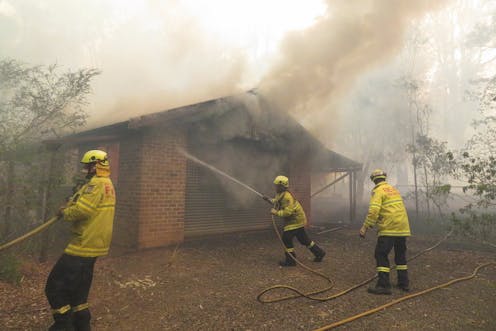Can earth-covered houses protect us from bushfires? Even if they’re a solution, it’s not risk-free
- Written by Alan March, Professor of Urban Planning, Faculty of Architecture, Building and Planning, The University of Melbourne

As extreme fire weather becomes more common across ever larger areas of Australia, we need new options for living with the risk of bushfire. Underground or earth-sheltered housing is one possibility. While still unusual, these homes are being built in bushfire-prone areas.
But before we embrace this form of housing as a widespread solution to increasing bushfire risks, we need to consider its complexities. Things to weigh up include the challenges of designing and building these homes, their costs and occupants’ behaviour. We also have limited real-world evidence of how such homes perform in bushfires.
A broader question is whether we should allow more people to live in bushfire-prone areas. If we let that happen it will lead to more deaths and injuries.
Read more: Australian building codes don't expect houses to be fire-proof – and that's by design
What does building such homes involve?
Earth-sheltered houses are often built into slopes, but can be built on flat ground, either by excavating or by mounding earth over the building. In Australia, concrete is generally used for the building structure to provide enough strength to allow soil to cover the roof and walls. The earth-covered areas can be vegetated.
Because of the amount of earth in contact with the exterior, care is needed to ensure the building is watertight and structurally sound.
The house usually has one main wall of windows facing away from the earth-covered side to provide natural light. To meet building regulations for ventilation, these buildings include rear windows in light wells or vents.
One advantage of earth-sheltered buildings is that their internal temperature remains quite stable. They use much less energy – up to 84% less for cooling and up to 48% less for heating – to maintain comfortable temperatures. (These figures are for all climates, compared to buildings with black roofs.)
These buildings can also offer greater opportunities for improved aesthetics (as the home blends into the landscape), landscaping, productive gardens and recreation. These benefits can offset having limited windows and constraints on building layouts.
Read more: How 'Earthships' could make rebuilding safer in bushfire zones
What about bushfire resistance?
Bushfires present complex risks. Earth-sheltered buildings are likely to be a useful but somewhat expensive and limited niche solution on challenging legacy sites where housing already exists.
Few such buildings have been subjected to fires so we have limited evidence of their efficacy. However, it is clear they can be engineered to resist the main ways bushfires attack buildings: heat, flames and embers.
Since earth largely covers the building, the most vulnerable parts are windows and other openings. These can be designed to resist heat and flame, depending on the modelled levels.
Bushfire-resistant measures are estimated to add costs of between $53,000 and $273,000 (2020 values) compared to a typical home construction, depending on the site. Glass is often a key component. Because they are highly susceptible to heat, the cost of windows that can withstand a worst-case fire is often prohibitive.
An earth-shelter build usually costs much more than standard once one adds up the engineering, excavation, concrete and construction costs.
Most earth-sheltered structures rely on one side of the building having large windows to admit enough natural light inside. This window side is typically oriented downhill towards views, with the rear built into the slope. Bushfires increase speed and intensity when moving uphill, so the window side usually receives the most intense bushfire attack.
On sites with limited space, this challenge is often difficult to resolve. Sometimes the only solution is to remove large amounts of natural vegetation. This is done at the expense of ecological goals. The loss of plants whose roots bind the soil could also increase landslip risks.
Read more: How our bushfire-proof house design could help people flee rather than risk fighting the flames
Should people even be in high-risk places?
While it is possible to engineer a bushfire-resistant structure with a low risk of destruction, that doesn’t eliminate the risks created by people themselves.
Human factors greatly increase risks, even in well-designed bushfire-resistant structures. Poor maintenance or later modification can put a property at risk. Examples include unsafe storage of gas bottles and fuel, woodpiles, and modification of or failure to secure doors, windows or shutters.
Residents may also modify vegetation around an earth-covered home in ways that increase risks. They might, for example, plant highly flammable species, or allow fuel loads to build up, including mulch they might have laid down.
Despite education campaigns, warnings and alerts, people continue to put themselves in many risky situations before and during bushfires. Reasons include alert fatigue, expenses of evacuation, dangers while driving, being in unfamiliar locations such as holiday houses, retrieving children, protecting livestock and pets, or protecting underinsured or uninsured property. If more people live in bushfire-prone areas, there will be more bushfire-related deaths and injuries among both residents and bushfire responders.
The psychological impacts on people affected by extreme fires are significant. Nearly three-quarters suffered anxiety for two years after Australia’s 2019-20 Black Summer bushfires. Even if a structure survives, the emotional burdens of isolation while under duress, loss of communications and the heat, smoke, darkness and noise of extreme fires are powerful and underestimated.
Yet people’s differing levels of awareness and ability are often ignored as a factor in bushfire risk.
Read more: Before we rush to rebuild after fires, we need to think about where and how
There’s a wider context to consider
It makes little sense to put more people in bushfire-prone locations that will likely become riskier over time. Solutions such as earth-sheltered buildings may be part of a suite of ways to reduce risks in existing bushfire-prone residential areas.
However, at a wider scale, building low-density housing in bushfire-prone areas is unnecessarily risky. It also conflicts with the compelling need to build at much higher densities in existing areas to house Australia’s growing population. Higher-density housing will allow better and more affordable access (because of economies of scale) to services, infrastructure, jobs and public transport.
Authors: Alan March, Professor of Urban Planning, Faculty of Architecture, Building and Planning, The University of Melbourne



















